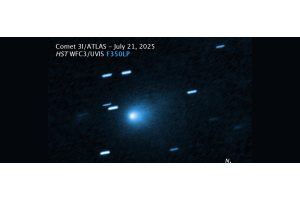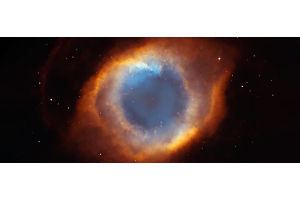
Jupiter is the favored target of many amateur astronomers, despite the beauty of its neighbor, Saturn. Point a telescope toward it and the reason soon becomes clear: world-sized moons that dance about the planet and a storm that’s persisted for centuries can capture your imagination. Add a scene that changes by the hour and you have a world worth visiting at every opportunity.
Ruler of the Gods, King of the Planets
Jupiter, of course, is one of the five planets easily visible to the naked eye and has been known since the dawn of time. It’s the second brightest planet in the sky (Venus being the brightest) and the fourth brightest object overall, with the Sun and Moon outshining everything else. No star can rival its brilliance when the planet is at its brightest, with only Sirius coming close when the planet is faintest.
An unmistakable sight in the night sky, it’s a shining, golden “star” that can be seen to slowly move among the stars as it gradually completes its 12-year orbit of the Sun. On average, it will spend about a year passing through each of the constellations of the zodiac, and while it’s not the fastest planet, changes in its position can still be noted within only a week or two. It can be a particularly lovely sight when it appears close to the crescent Moon or another planet in the twilight sky.

A Solar System in Miniature
Fortunately, you won’t need to invest in expensive equipment to see more. A decent set of 10x50 binoculars are all that’s needed to show the planet’s four largest moons. You may need to rest against something to steady the view, but you should easily spot up to four, tiny starlike points on either side of the planet.
These moons, named Io, Europa, Ganymede, and Callisto (in order of distance from the planet) are also known as the Galilean Satellites, after the Italian astronomer who discovered them. Galileo first saw them in either December 1609 or January 1610, using a simple telescope he’d built himself.
Of the four, Io and Europa are about the same size as our own Moon, with Europa being slightly smaller and Io being slightly larger. Callisto is roughly the same size as Mercury, while Ganymede is the largest of all the moons in the solar system. Despite their size, you won’t see them as anything more than points of light in binoculars or small telescopes.
You can, however, watch them move over the course of several hours. If Jupiter is visible throughout the night, it’s worth beginning your observing session with a peek at the planet and then returning near the end to see how the view has changed. At the very least, you’ll probably notice that the moons have changed position.
On some nights, you’ll see all four moons, while on others you may only see three or maybe even two. That’s because they’ll either disappear behind the planet or pass in front of it. Depending upon the moon in question, you could see a moon disappear and then reappear within just two hours.
The moons can also cast shadows upon Jupiter’s disc as they pass in front of (or transit) the planet, but you’ll need a telescope to see these. An aperture of only three inches is enough to show a tiny, black spot on the planet’s face. Single shadows typically occur at least once a day, but a double shadow - cast by two moons simultaneously - are rare and may only occur about once a month.
When this happens, you won’t be able to see the moon itself against the background of the planet, but you can certainly see when the transit begins and ends. Likewise, as the moon passes behind the planet you’ll see it disappear as Jupiter’s shadow engulfs it. It happens so quickly that if you look away for a few moments you may actually miss it.
Known as an occultation, these events also typically occur once a day, but maybe once a month two moons will be hidden, leaving only two remaining to be seen. Again, like transits, these are easily seen with a small telescope and occur with clockwork precision. If you’d like to find out which events might be visible today, check out Sky & Telescope’s observing tool!

Dark Bands and a Great Red Spot
The moons aren’t the only thing worth observing at Jupiter. Point almost any telescope toward the planet and you’ll immediately notice a number of dark bands crossing its disc. These are patterns within the atmosphere of Jupiter itself, with the most apparent being the equatorial bands. Sometimes only one broad band will be visible while at other times you’ll see two thinner bands, just a little to the north and south of Jupiter’s equator. You’ll also notice darker areas at the planet’s poles.
Larger telescopes will show a little more detail in the atmosphere; the bands might appear mottled, while other, thinner bands might appear in the mid-latitudes between the equator and the poles. But there’s one feature that almost every aspiring astronomer strives to see: the famous Great Red Spot.
No one knows for sure how long the spot has existed, but it’s probably been observed since the second half of the 17th century. It’s a huge, Earth-sized storm that roars through the atmosphere with wind speeds in excess of 250 mph, making terrestrial hurricanes seem tame in comparison.
Unfortunately, your chances of seeing this magnificent feature with anything less than a five-inch scope are slim; for starters, it’s been shrinking over time and it’s recently shown signs of unraveling. Again, Sky & Telescope magazine has an online tool to calculate the times when the spot will be visible and it’s worth investing in a filter to enhance the contrast. A blue 80A filter is a good, general-purpose accessory for observing the planets and will help the spot to stand out.
Moons, shadows, bands, and storms all contribute to making Jupiter the most dynamic sight in the solar system. Nowhere else will you see as much detail with only a small telescope and the world will never disappoint. The king of the planets has reigned supreme for centuries, and while he shows no signs of ending his rule any time soon, you should never ignore an opportunity to enjoy his company!

Learn More
Interested in learning more about the planets in our solar system? Check out our Astronomy Hub!
This Article was Last Updated on 08/14/2023











